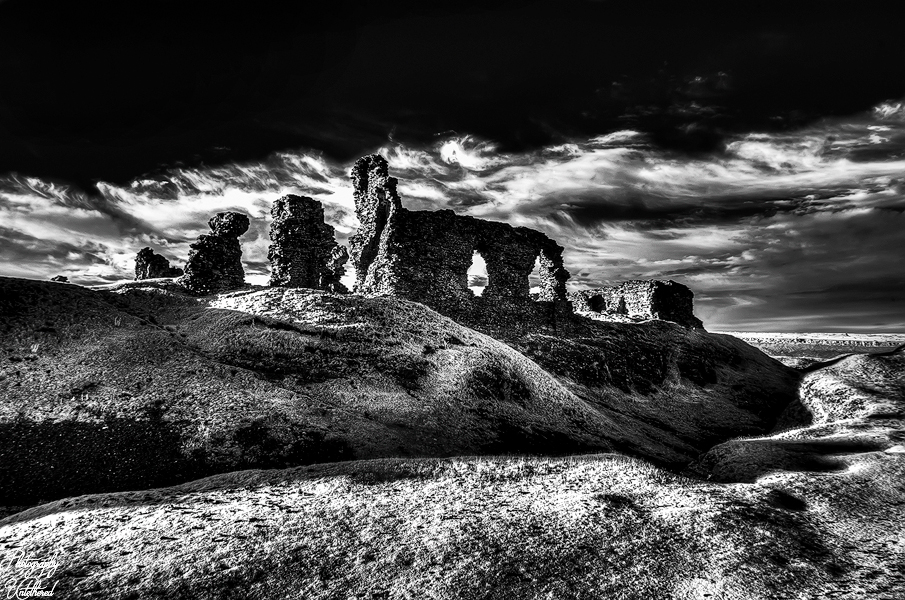Castell Dinas Brân is situated on the edge of the Berwyn Mountains in North Wales. Castell Dinas Brân looms above the River Dee and the town of Llangollen, famous for its canal and aqueduct. Translated as “Crow Castle”, Dinas Brân, a 13th-century castle, is a shadow of its former self. What is left is a ghostly ruin, situated high on what first impressions appear to be an unscalable precipice. Its dramatic and imposing location has made it a significant landmark and a subject of numerous historical accounts, legends, and artistic inspirations.
The name “Dinas Brân” has various interpretations, most commonly translated as “Crow’s Fortress” or “Fortress of Brân,” with “Brân” potentially referring to an individual or a nearby stream. The English name “Crow Castle” has been in use since at least the 18th century.
The site of Castell Dinas Brân has a history stretching back to the Iron Age, around 600 BCE, when a large hillfort was constructed by the Celtic tribe known as the Ordovices. This early fortification included an earthen rampart, likely with a wooden palisade, and a deep ditch to defend its more vulnerable southern slopes. The strategic importance of the hilltop was recognised long before the medieval castle was built, as evidenced by the Iron Age earthworks that still encompass portions of the stone fortress.
The presently visible stone castle was likely built in the 1260s by Gruffydd Maelor II, a prince of Powys Fadog. This construction followed the destruction of an earlier wooden fortification, which may have been ruled by Gruffydd Maelor’s father, Madog ap Gruffydd Maelor. The castle’s design, including its rectangular stone defensive walls, a keep, a gatehouse, and a characteristic D-shaped “Welsh Tower,” reflects typical Welsh castle architecture of the period. A steep slope naturally defended the northern wall of the castle, while the southern and eastern sides were reinforced with a 20-foot-deep rock-cut ditch and counterscarp bank.
Despite its formidable appearance, Castell Dinas Brân had a remarkably short active life, lasting scarcely 20 years. In 1277, during Edward I’s initial conquest of Wales, the castle was abandoned and set alight by its Welsh defenders, likely the younger sons of Gruffydd Maelor II, Owain and Gruffudd, who were allies of Llywelyn ap Gruffudd, Prince of Wales. This act was possibly to prevent the castle from falling intact into English hands. Although the castle was not severely damaged by the fire, and Henry de Lacy, Earl of Lincoln, who led the English forces, recommended its repair and garrisoning, it was never fully restored by the English.
After the death of Llywelyn in 1282, the castle and much of Powys Fadog were granted to John de Warenne, Earl of Surrey, who chose to build a new castle at Holt rather than rebuild Dinas Brân, leaving it to fall into ruin.
The Keys To Avalon:
And what of the Dark Ages and the most mythical warrior of all? King Arthur has been linked to Tintagel in Cornwell and many places, the length and breadth of England and Scotland. Llangollen, however, also lay claim to this mystic warrior.
Local authors Steven Blake and Scott Lloyd have laid Llangollen’s claim to the king of the Britons in their book “The Keys To Avalon”, which makes for interesting reading.
The truth surrounding King Arthur will forever remain immersed in myth and legend. Nevertheless, Llangollen and the surrounding area is steeped in Welsh myths and legends. And it doesn’t take much stretch of the imagination when visiting Dinas Brân to visualise a warrior king within this mythical landscape.
Aneirin
Extract from his “Y Gododdin” (c.AD 600)
He charged before three hundred of the finest,
He cut down both centre and wing,
He excelled in the forefront of the noblest host,
He gave gifts of horses from the herd in winter.
He fed black ravens on the rampart of a fortress
Though he was no Arthur.
Among the powerful ones in battle,
In the front rank, Gwawrddur was a palisade.
Ghostly Spectre:
Whenever I visit Llangollen, the spectre of Dinas Brân seems to pervade my thoughts, and because of this, I dearly wanted to capture it on camera.
No ordinary shot would do, however, Castell Dinas Brân has a surreal, mysterious, and eerie feel to it, and I thought only through the medium of infrared could I hope to convey that sensation.
It was time to dust off the Nikon infrared body for some action. So one late afternoon with high clouds and blue skies, I set out. This was ideal, as the blue sky would show up black in infrared and convey that dark, sinister look I wanted. I deepened down the late afternoon shadows to add to the eerie feeling.
Hopefully, I have done it justice.
The website is self-funded, and my work is free. All profits from the site’s product links go to SightSavers; if you have enjoyed any aspect of this site, please consider a giving a donation here. No one should go blind from avoidable causes. How many people’s sight will you help us save today?
Fragmented Memory 🙂
